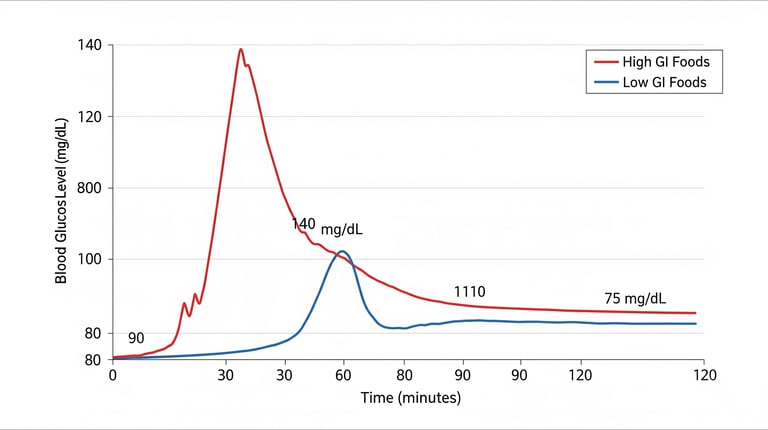The Science Behind Low GI: How It Supports a Longer, Healthier Life
Trulo team
8/21/20254 min read
We often hear about the benefits of "healthy eating," but what does that truly mean on a cellular level? While the previous post introduced the Glycemic Index (GI) as a simple concept of "fast" vs. "slow" carbs, the science behind it reveals a profound impact on our long-term health. This isn't just a diet trend; it's a fundamental principle of human physiology with a growing body of research to back it up.
So, how does a simple shift from a high GI to a low GI diet help us live a longer, healthier life? The answer lies in how our body manages blood glucose and insulin.
The Core Science: Flattening the Glucose Curve
Every carbohydrate we eat is broken down into glucose, which is our body's primary fuel source. The GI measures how quickly this process happens.
High GI Foods: When you eat a high GI food like white rice or maida, the carbohydrates are rapidly digested and flood the bloodstream with glucose. To manage this sudden spike, your pancreas releases a large surge of insulin. This is a crucial hormone that helps move glucose into your cells for energy. However, frequent spikes and large insulin releases can lead to a condition called insulin resistance, where your cells become less responsive to insulin's signal. This forces your pancreas to work even harder over time, a primary risk factor for type 2 diabetes.
Low GI Foods: Conversely, low GI foods like legumes (dals) and whole grains (millets) are digested slowly due to their high fiber content. This results in a gradual, gentle rise in blood glucose and a controlled, moderate release of insulin. This sustained energy release is gentle on your system, preventing the blood sugar "rollercoaster" and maintaining your cells' sensitivity to insulin.
Specific Health Benefits Backed by Research
The impact of this stable blood sugar control is far-reaching and is supported by decades of scientific research.
1. Diabetes Prevention and Management
This is the most well-documented benefit of a low GI diet. A high intake of high GI foods is linked to a higher risk of developing type 2 diabetes.
A systematic review and meta-analysis published in Frontiers in Nutrition found that low GI diets significantly lowered insulin resistance (IR) in adults without diabetes. The study concluded that "early intervention with a LoGI diet can reduce the risk of developing diabetes mellitus by decreasing IR." (Frontiers in Nutrition, 2025).
For individuals with diabetes, low GI diets are a cornerstone of management. Studies have shown they can improve long-term glycemic control, as measured by a decrease in HbA1c levels, which is the average blood sugar level over several months (Diabetes Care, 2003).
2. Sustainable Weight Management
Low GI diets are effective for weight management not just by reducing calories, but by addressing the root causes of overeating: hunger and energy crashes.
The steady release of glucose from low GI foods helps you feel full and satisfied for longer. Research presented at the Society for Endocrinology found that a low GI meal increased levels of the gut hormone GLP-1, which is known to suppress appetite and promote a feeling of fullness (Society for Endocrinology, 2009).
A systematic review and meta-analysis from the journal Nutrients concluded that low GI diets were more effective than other diets at controlling body mass and body mass index (BMI), particularly in long-term studies (Nutrients, 2022).
3. Cardiovascular Health
The link between a high GI diet and heart disease is strong and has been explored in large-scale studies.
A study involving over 137,000 participants in the PURE (Prospective Urban Rural Epidemiology) study found that individuals who consumed a high GI diet had a 21% higher risk of a major cardiovascular event or death compared to those on a low GI diet. The study highlighted that high GI diets can lead to chronic inflammation and oxidative stress, which contribute to the hardening of arteries (atherosclerosis) (ResearchGate, 2021).
By helping to manage blood sugar, insulin, and body weight, a low GI approach indirectly reduces major risk factors for heart disease, including high blood pressure and unhealthy cholesterol levels.
A Practical Approach to a Longer, Healthier Life
The science is clear: the cumulative effect of choosing low GI foods over a lifetime can lead to a significant reduction in the risk of chronic diseases. The good news is, you don’t have to completely change your diet overnight. Start with small, evidence-based swaps.
Switch your grains: Replace white rice with basmati rice or brown rice, or even better, whole grains like jowar, bajra, or quinoa.
Embrace the power of pulses: Make dal a staple of your meals. The high fiber and protein content of lentils and beans are a perfect way to lower the overall GI of any dish.
Balance your plate: Always pair a high GI food with a source of protein, healthy fats, and fiber to slow down glucose absorption. For example, have your roti with a side of chana masala and a fresh vegetable salad.
Smart snacking: Choose nuts, seeds, or a piece of fruit like an apple or berries over processed snacks, which are typically high in GI.
The science behind the Glycemic Index is a powerful reminder that every food choice we make is an investment in our future health. By making small, informed changes, we can take control of our blood sugar, manage our weight, and build a foundation for a longer, more vibrant life.


